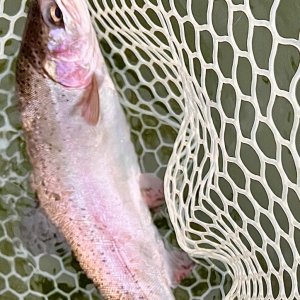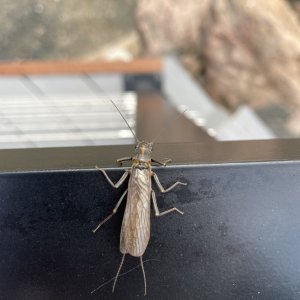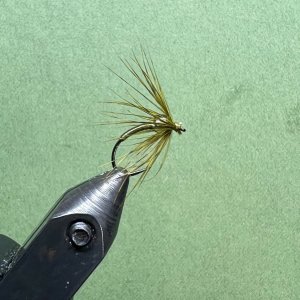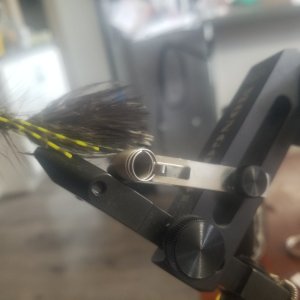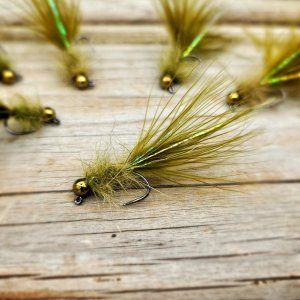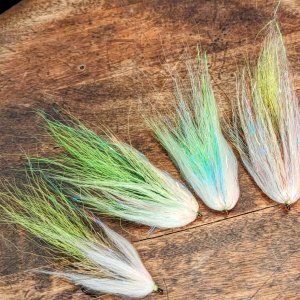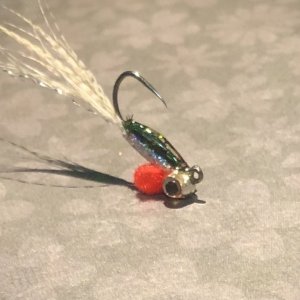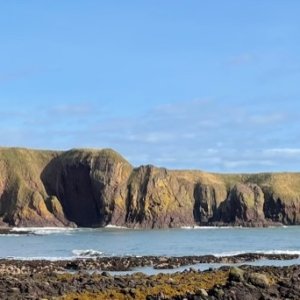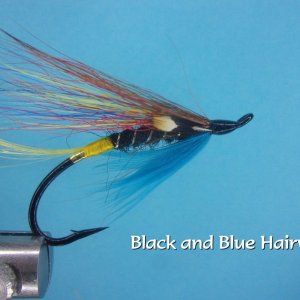I'm pretty sure you're right. Fall Chinook, being generally large fish, don't like to enter the dinky creek at the lower Kalama hatchery. In order to secure the fall Chinook hatchery broodstock, the weir was necessary to prevent those fish from just swimming on upstream and spawning in the river, which is still pretty small in the fall. Coho spawn in small creeks and are more than willing to swim up dinky little hatchery creeks.IF!!!!!! I remember right the purpose of the wier is to remove hatchery chinook. The steelhed and coho might be delayed but otherwise unaffected. That said the good coho, "B" runs are the October/November fish which will come in when the water is high and will bypass the weir.
Talking about the lower weir. Not up at the Hatchery.
Anyone feel free to correct me..
You are using an out of date browser. It may not display this or other websites correctly.
You should upgrade or use an alternative browser.
You should upgrade or use an alternative browser.
Kalama River
- Thread starter The Coho King
- Start date
skyrise
Steelhead
As Rob said they were known as springers. We spent much time chasing them back then. My favorite month was June. Good amount of water and not too hot during the day. My largest was 19 lbs. and was a hatchery fish as they were doing that selective sampling to get larger fish to return back then on the washougal anyway. And then there was that permit you could get from the landowner on the upper Kalama that allowed you to fish on his property which was very good for late returning winter fish some of which were very nice size.
For most of their existance, fish hatcheries have kept the earliest returning fish as broodstock to ensure getting as many as necessary to operate the program. This led to run timings becoming earlier in the season than the natural wild runs. This is how the Chambers Creek hatchery winter steelhead came to peak in December and led to more hatchery summer steelhead returning in April, May, and June instead of the peak natural return month of July. When the hatchery summer steelhead programs were really large on some rivers and smolt survival rates were much higher, summer steelhead could be found occasionally as early as late January!, although February and March were far more common. So the earliest hatchery summer steelhead return timing had a significant overlap with the remant late wild winter steelhead returns. The principle difference of course is that the late winter steelhead spawned that spring, while those early summer runs held over in the river for nearly a year before they were ripe to spawn.Am I correct to remember a run of large steelhead that entered the Kalama and other SW Washington rivers in May and June, large fish as much as 20# and hot. What stock were they? Native, I presume. I snorkeled the east fork Lewis below Lucia Falls (?) and it was plugged with large fish. About the same time I started flyfishing in ‘68-‘69; never caught one over 10# but saw some that appeared much larger.
Now, about those large steelhead. WDG at the Washougal hatchery began in the mid-70s selecting 3-salt summer steelhead for broodstock with the intent of creating larger returning summer steelhead. (Most Skamania type summer steelhead return to freshwater as 2-salt fish and generally weigh 8 pounds.) The experiment worked, and larger hatchery summer steelhead returned in the late 70s and early 80s to the rivers that received their hatchery steelhead fingerlings from the Skamania hatchery. A lot of 17 and 18 pound 3-salt, and allegedly some 20 pound, summer steelhead showed up in the Washougal, EF Lewis, Kalama, and Cowlitz Rivers for a few years. I don't know this for a fact, but what I was told regarding discontinuing that program is that the smolt to adult survival rate was lower when only 3-salt returns were used as broodstock. That makes a certain amount of sense in that for each year spent in the ocean, more fish are lost to natural mortality factors. However, as fish get older and larger, the mortality rate declines, which also makes sense. The other part of the story is that whomever the hatchery management decider was, decided that the programs should try to mimic the natural populations instead of creating frankenfsih. About that same time, most hatcheries also began taking their broodstock from across the natural timing spread instead of taking only from the earliest returns. So I give that part of the explanation some credence. The obvious exception was to continue the early timing of the Chambers Creek hatchery winter fish because it became obvious that by coincidence the Department had created a timing separation between hatchery winter steelhead and wild winter steelhead and that this was a good thing, genetically, ecologically, and in just about every way one could measure.
Again, about snorkeling at Lucia Falls. In May at the base of the falls one might reasonably observe early summer steelhead that would average 8 pounds, except in the years when there was more than a normal distribution of 3-salt fish, co-mingled with some late timed winter steelhead that might average about 12 pounds in those days, with some members of that population being in the teens and 20+ pound range. So there you have it; well, most of it anyway.
On the Washougal we referred to them as "Springers" because they arrived around the same time as spring chinook they I imagine were intercepted by gillnets in greater numbers that other Summer runs, and because they were in the river for so long, often in the biggest pools of the most remote sections of river they were heavily poached and lastly, because they were the first arriving summer runs they were heavily preyed upon by hatchery programs.
They are the fish that made Portland area anglers fish 9wts and reels with 300 yards of backing. pretty rare these days.
Washougal springers were they closest thing to a tropical flats, or pelagic species that I had encountered before I knew what that comparison meant.
In 1970's & 80's I fished the Kalama a lot. I also cmped in my truck or with a tent up around the Holy Water and near the deadline. I was good fishing after Aug 1rst. That is when I started releasing wild fish and only keeping hatchery fish. It was easy to tell the difference. I loved fishing there. I also fly fished the lower river a lot. It was a fly fishermans Mecca for steelhead and Salmon. I met people from all parts of the country and all walks of life. It saddens me to hear that in he interest of saving wild or native fish they have all but ruined what once was a thriving river. AsAlthough the Kalama had natural runs of wild spring Chinook, summer and winter steelhead, it became one of the most heavily stocked streams on the lower Columbia River using Mitchell Act funds. Mitchell Act is mitigation money for fisheries impacts of federal dams on the Columbia River. WDG and WDF, predecessors to today's WDFW thought it was a waste of money to stock fish upstream of Bonneville or other mainstem dams because of the heavy mortality losses at each dams. This was before the many fish passage improvements that got under way in the 1980s.
WDG stocked hatchery steelhead (Chambers Creek winter run and Skamania summer run) in the Kalama in numbers approximating 60 to 70k each. This was at a time when smolt to adult return rates of 5 to 10% were routine. 6 or 7 thousand returning steelhead made for some pretty good sport fishing, summer and winter. ESA listings have been the primary reason, as far as I know, for reducing, then eliminating some of the hatchery stocking. Chambers Creek fish have been eleminated, as their undesirable Puget Sound genetics are not appreciated by the ESA. Skamania summer runs are still stocked in reduced numbers. They are allowed since they are also a native lower Columbia River stock, like the native Kalama fish. I believe most hatchery steelhead are stopped at the weir at Kalama Falls hatchery, with only wild fish being allowed upstream toward the fly fishing only section.
I used to fish the Holy Water a lot in the 1970s and usually camped right there. There were about 4 potential camping sites there as I recall. The gate was added many years later.
The upshot is that wild steelhead returns are a small fraction of what they used to be, like everywhere these days. And they are a tiny fraction of what the large hatchery returns used to amount to, in those days when smolt to adult survival rates made expensive hatchery programs economically attractive.
I know this is an old post. I just found it. I use to fish Kakanmma 70's & 80's. That's when I was also learning to fly fish. The Kalama was my go to river. In the 80's when Mt St. Helen's blew a lit of the Cowlitz and Toutle river fish reverted upriver to avoid the ash coming down those rivers. The Kalame was stacked with so many fish you could almost walk on them. In the late 1990's I moved to Oregon.Although the Kalama had natural runs of wild spring Chinook, summer and winter steelhead, it became one of the most heavily stocked streams on the lower Columbia River using Mitchell Act funds. Mitchell Act is mitigation money for fisheries impacts of federal dams on the Columbia River. WDG and WDF, predecessors to today's WDFW thought it was a waste of money to stock fish upstream of Bonneville or other mainstem dams because of the heavy mortality losses at each dams. This was before the many fish passage improvements that got under way in the 1980s.
WDG stocked hatchery steelhead (Chambers Creek winter run and Skamania summer run) in the Kalama in numbers approximating 60 to 70k each. This was at a time when smolt to adult return rates of 5 to 10% were routine. 6 or 7 thousand returning steelhead made for some pretty good sport fishing, summer and winter. ESA listings have been the primary reason, as far as I know, for reducing, then eliminating some of the hatchery stocking. Chambers Creek fish have been eleminated, as their undesirable Puget Sound genetics are not appreciated by the ESA. Skamania summer runs are still stocked in reduced numbers. They are allowed since they are also a native lower Columbia River stock, like the native Kalama fish. I believe most hatchery steelhead are stopped at the weir at Kalama Falls hatchery, with only wild fish being allowed upstream toward the fly fishing only section.
I used to fish the Holy Water a lot in the 1970s and usually camped right there. There were about 4 potential camping sites there as I recall. The gate was added many years later.
The upshot is that wild steelhead returns are a small fraction of what they used to be, like everywhere these days. And they are a tiny fraction of what the large hatchery returns used to amount to, in those days when smolt to adult survival rates made expensive hatchery programs economically attractive.
Now it is sad to hear what has been done to the Kalama, East Fork Lewis, Rivers. In the name of management WGD seems to have devastated great runs on beautiful rivers. Does Skamania Hatchery on the Washougal still raise hatchery steelhead. Even though all these rivers had large hatchery programs there were still many large healthy wild fish in all of the rivers. I cau g t and saw caught many 15, 20 and bigger fish caught on these rivers regardless the hatchery fish competing for the river.
Rob Allen
Life of the Party
You remind me of a great point. It's very easy to see that we've lost fisheries, we've lost and are losing populations of fish. However we have lost a lot more than that we have lost nearly all of a once great and thriving steelhead culture particularly, at least from my view, the culture of Portland Oregon area summer steelhead. A very rich and colorful history and heritage that I just barely got to encounter.In 1970's & 80's I fished the Kalama a lot. I also cmped in my truck or with a tent up around the Holy Water and near the deadline. I was good fishing after Aug 1rst. That is when I started releasing wild fish and only keeping hatchery fish. It was easy to tell the difference. I loved fishing there. I also fly fished the lower river a lot. It was a fly fishermans Mecca for steelhead and Salmon. I met people from all parts of the country and all walks of life. It saddens me to hear that in he interest of saving wild or native fish they have all but ruined what once was a thriving river. As
I know this is an old post. I just found it. I use to fish Kakanmma 70's & 80's. That's when I was also learning to fly fish. The Kalama was my go to river. In the 80's when Mt St. Helen's blew a lit of the Cowlitz and Toutle river fish reverted upriver to avoid the ash coming down those rivers. The Kalame was stacked with so many fish you could almost walk on them. In the late 1990's I moved to Oregon.
Now it is sad to hear what has been done to the Kalama, East Fork Lewis, Rivers. In the name of management WGD seems to have devastated great runs on beautiful rivers. Does Skamania Hatchery on the Washougal still raise hatchery steelhead. Even though all these rivers had large hatchery programs there were still many large healthy wild fish in all of the rivers. I cau g t and saw caught many 15, 20 and bigger fish caught on these rivers regardless the hatchery fish competing for the river.
One of the says I have a fond memory of was a chance meeting I was a part of as a teenager. Bill McMillan, John Hazel, Randy Stetzer and Marty Sherman all standing around at a pool on the Washougal talking about steelhead.
Not much to stand around and talk about anymore.
Tomorrow I am buying, I hope, a print. Grant Linn's. "Washougal steelhead" it's at an estate sale of a local steelheader. The culture may be gone but there are remnants. Fossils I guess you might call them now.


